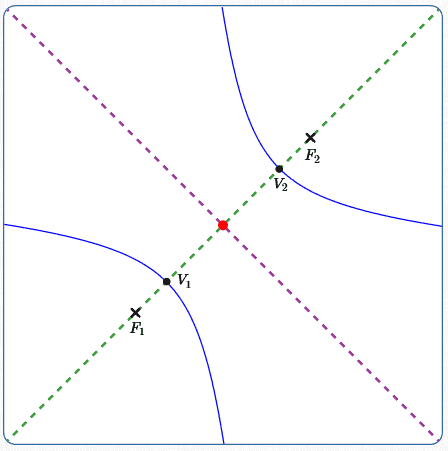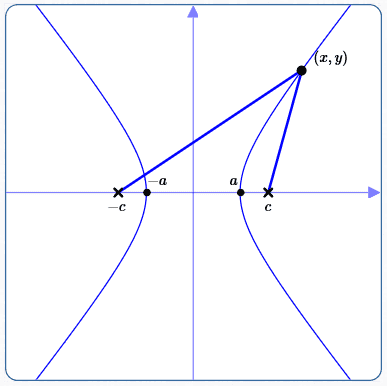 Equations of Hyperbolas in Standard Form (Part 1)
Equations of Hyperbolas in Standard Form (Part 1)
(This page is Part 1. Click here for Part 2.)
Hyperbolas were introduced in two prior lessons:
In this current section, a hyperbola is positioned with its center at the origin and foci on the $x$-axis or $y$-axis. These placements result in the so-called ‘standard forms’ for a hyperbola, which—as you'll see—are very simple equations!
If you're short on time, jump right to the Summary of Equations of Hyperbolas.
Review and Additional Notation

Consider a hyperbola with foci $\,F_1\,$ and $\,F_2\,$ and hyperbola constant $\,k\,.$
Recall from the previous section that:
Definition of Hyperbola
By the definition of hyperbola, every point $\,P\,$ on the hyperbola satisfies:
$$\cssId{s11}{|d(P,F_1) - d(P,F_2)| = k}$$Here, $\,d(A,B)\,$ denotes the distance between points $\,A\,$ and $\,B\,.$
Major Axis and Vertices of a Hyperbola

The major axis of a hyperbola is the line through the foci, shown above dashed green.
The vertices of a hyperbola are the two points where the hyperbola intersects its major axis. Above, they are denoted by $\,V_1\,$ and $\,V_2\,$ (with $\,V_1\,$ closest to $\,F_1\,$).
A hyperbola ‘shows’ its hyperbola constant as the distance between the vertices. That is, $\,d(V_1,V_2) = k\,.$
Here is some additional notation:
Center of a Hyperbola

Let $\,C\,$ denote the midpoint of the line segment from $\,F_1\,$ to $\,F_2\,.$ By definition, $\,C\,$ is the center of the hyperbola, and is shown above in red.
Minor Axis of a Hyperbola

The minor axis of a hyperbola is the perpendicular bisector of the line segment between the foci.
Equivalently, the minor axis is the line through the center that is perpendicular to the major axis. The minor axis is shown above dashed purple.
Summary: Major Axis, Center, Minor Axis

The major axis of the hyperbola is the line through the foci; it is dashed green.
The center of the hyperbola is the midpoint of the line segment connecting the foci; it is shown in red.
The minor axis of the hyperbola is the line through the center that is perpendicular to the major axis; it is dashed purple.
Derivation of the Equation of a Hyperbola: Center at the Origin, Foci on the $x$-axis
Position the Hyperbola

As shown above, position a hyperbola with center at the origin and foci (marked with ‘x’) on the $x$-axis. With this positioning, the $x$-axis is the major axis; the $y$-axis is the minor axis.
Notation ($\,c\,$ and $\,a\,$)
Define:
$c := \,$ the distance from the center (the origin) to each focus. Since $\,c\,$ is a distance, $\,c \gt 0\,.$ The coordinates of the foci are therefore $\,(c,0)\,$ and $\,(-c,0)\,.$
$a := \,$ the distance from the center to each vertex. Since $\,a\,$ is a distance, $\,a \gt 0\,$; also, $\,a \lt c\,.$ The coordinates of the vertices are therefore $\,(a,0)\,$ and $\,(-a,0)\,.$
(Recall that ‘$\,:=\,$’ means ‘equal, by definition’.)
Hyperbola Constant
The hyperbola constant is the distance between the vertices, which is $\,2a\,.$
Summary: Hyperbola Derivation Notation

Hyperbola with foci on $x$-axis and center at the origin
$c := \,$ distance from center to each focus
$a := \,$ distance from center to each vertex
Note that $\,0 \lt a \lt c\,.$
Use the Definition of Hyperbola on a Typical Point

Let $\,(x,y)\,$ be a typical point on the hyperbola. Thus, the difference of its distances to the foci is the hyperbola constant, $\,2a\,.$ That is:
Use the distance formula and make obvious simplications:
Get Rid of the Absolute Values
Recall that for $\,k\ge 0\,,$ $\,|x| = k\,$ is equivalent to $\,x=\pm k\,.$ Use this fact to get rid of the absolute value symbols in (*):
Make sure you appreciate the compactness that the ‘plus or minus’ symbol ‘$\,\pm\,$’ provides! Without it, (**) would need to be written as
$$ \small \begin{gather} \cssId{s64}{\sqrt{\bigl(x + c\bigr)^2 + y^2} - \sqrt{\bigl(x - c\bigr)^2 + y^2} = 2a}\cr \cssId{s65}{\text{or}}\cr \cssId{s66}{\sqrt{\bigl(x + c\bigr)^2 + y^2} - \sqrt{\bigl(x - c\bigr)^2 + y^2} = -2a} \end{gather} $$Here's the good news—that bothersome ‘plus or minus’ symbol will disappear soon!
A Radical Equation Results
Equation (**) is a radical equation in two variables ($\,x\,$ and $\,y\,$). A radical equation, by definition, has at least one variable ‘inside’ a radical.
A standard approach for working with radical equations is to ‘isolate and undo’. To isolate an expression (like a radical) means to get it all by itself on one side of the equation .
Be on the lookout for this ‘isolate and undo’ sequence (used twice!) in the algebraically-intensive simplifying procedure below.
‘Undoing’ a Square Root
For us, the radicals that appear in (**) are square roots; a square root is ‘undone’ by squaring. That is: for all $\,t \ge 0\,,$ $\,(\,\sqrt t\,)^2 = t\,.$ By squaring a square root, the square root disapppears!
The Expressions Under the Square Roots in (**) are Nonnegative
For all real numbers $\,x\,,$ $\,y\,$ and $\,c\,,$ both expressions under the square roots in (**) are nonnegative:
$$ \begin{gather} \cssId{s82}{(x+c)^2 + y^2 \ge 0}\cr\cr \cssId{s83}{(x-c)^2 + y^2 \ge 0} \end{gather} $$Why? Squared quantities are always nonnegative: for all real numbers $\,t\,,$ $\,t^2 \ge 0\,.$ Also, sums of nonnegative quantities are nonnegative.
Apply the ‘Isolate and Undo’ Technique to (**)
We'll choose to isolate the first square root that appears (going from left to right) in (**). It's conventional to isolate it (i.e., get it all by itself) on the left-hand side of the equation.
It doesn't matter which square root we isolate first, but a choice had to be made. There's a lot of algebra here, so breathe deeply and take your time!
Isolate the first square root
‘Undo’ the isolated square root by squaring both sides
FOIL the right-hand side
Simplify; note that both $\,(2a)^2\,$ and $\,(-2a)^2\,$ give $\,4a^2$
FOIL
Subtract $\,\color{red}{x^2 + c^2 + y^2}\,$ from both sides
Isolate the remaining square root term
Simplify notation: replace $\,-(\pm)\,$ with $\,\mp$
Divide by $\,\color{red}{4}$
Square both sides
Multiply out the left-hand side
FOIL
Distributive law
Add $\,\color{red}{2a^2cx}\,$ to both sides
Re-arrange: variable terms on left, constant terms on right
Multiply both sides by $\,-1$
Factor
Notation ($\,b\,$)
Since $\,0 \lt a \lt c\,,$ we have $\,a^2 \lt c^2\,,$ so that $\,c^2 - a^2 \gt 0\,.$
Define $\,b\,$ to be the positive number such that $\,b^2 = c^2 - a^2\,.$ Note that $\,b\,$ is strictly greater than zero.
Rewrite ($\dagger$) to Eliminate $\,c\,,$ and Simplify
Use $\,b^2 = c^2 - a^2\,$ to rewrite ($\dagger$):
$$ \cssId{s136}{b^2x^2 - a^2y^2 = a^2b^2} $$Note that $\,a \gt 0\,$ and $\,b \gt 0\,,$ so $\,ab \gt 0\,$ and hence $\,a^2b^2 \gt 0\,.$ Dividing both sides by $\,a^2b^2\,$ gives:
$$ \begin{gather} \cssId{s141}{\frac{b^2x^2}{a^2b^2} - \frac{a^2y^2}{a^2b^2} = \frac{a^2b^2}{a^2b^2}}\cr\cr \cssId{s142}{\frac{x^2}{a^2} - \frac{y^2}{b^2} = 1}\cr\cr \end{gather} $$Summary
The equation of a hyperbola with center at the origin and foci along the $x$-axis is
$$ \cssId{s145}{\frac{x^2}{a^2} - \frac{y^2}{b^2} = 1} $$where $\,b^2 := c^2 - a^2\,.$
The foci are determined by solving the equation $\,c^2 = a^2 + b^2\,$ for $\,c\,.$ The coordinates of the foci are $\,(-c,0)\,$ and $\,(c,0)\,.$